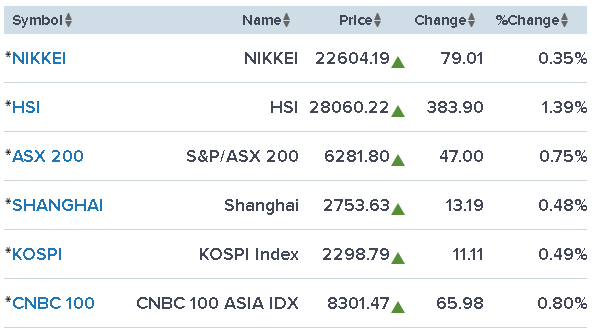
Asian shares advanced on Monday despite trade returning to the fore after another set of tariffs on U.S. goods were announced by China as investors digested the People’s Bank of China’s move to stabilize the yuan.
The Nikkei 225 edged up by 0.14 percent in the early going, with utilities edging higher in the morning. Overall gains were capped by declines in the banking and metal products sectors. Among index heavyweights, Fanuc gained 1.1 percent while Fast Retailing eased 0.27 percent.
In South Korea, the Kospi added 0.39 percent. Steelmakers and retailers contributed to gains, with Posco jumping 4.04 percent. Among tech names, index bellwether Samsung Electronics added 0.44 percent while SK Hynix dropped 3 percent.
Down Under, the S&P/ASX 200 rose 0.68 percent, with the materials subindex leading gains in the morning as mining majors climbed. BHP was up 2.11 percent and Rio Tinto advanced 1.1 percent.
Over in Hong Kong, the Hang Seng Index rose 0.89 percent after closing lower for the past five straight sessions. All sectors traded higher in the morning, with the advance led by more than 1 percent gains in information technology, financials and energy.
Mainland Chinese stocks, however, lagged, with the Shanghai Composite slipping 0.18 percent and the smaller Shenzhen Composite declining 0.58 percent.
MSCI’s index of shares in Asia Pacific excluding Japan tacked on 0.66 percent in Asia morning trade.
The broad gains seen in Asia came after new tariffs on U.S. goods announced by China on Friday pushed the trade dispute between the two countries back into the spotlight. China said it was preparing levies, ranging from 5 percent to 25 percent, on around $60 billion in U.S. imports, including many agriculture-related goods.
China said the latest duties would be implemented if the U.S. proceeded to impose more tariffs on Chinese goods. U.S. President Donald Trump had earlier this month asked the U.S. Trade Representative to consider increasing proposed tariffs on $200 billion worth of Chinese goods to 25 percent, from an initially announced 10 percent rate.
“In the last couple of months, the idea of a trade war is being used as an excuse by the asset allocators to rotate out of all emerging markets and what that’s done is to create a sort of a liquidity flow, which has made it very difficult for market indices to fight against,” Mark Tinker, head of Framlington Equities Asia at AXA Investment Managers, told CNBC’s “Squawk Box.”
“There’s no doubt that there’s a lot of noise in what is a quiet season for a lot of investors,” he added.
In foreign exchange, the offshore yuan slightly extended gains made on Friday when the People’s Bank of China moved to stabilize the currency following recent weakness.
The offshore yuan last traded at 6.8336 to the dollar — stronger than Friday’s intraday weak point, which exceeded 6.9. The on-shore yuan, meanwhile, traded at 6.8035 to the dollar. Before the market open, the central bank had fixed the yuan mid-point at 6.8513, its lowest level since May 31, 2017.
The dollar index, which tracks the greenback against a basket of currencies, was mostly steady at 95.221 at 9:43 a.m. HK/SIN. Against the yen, the dollar traded at 111.20.
Wall Street had gained on Friday as investors digested the latest jobs data. Nonfarm payrolls rose by 157,000 in July, missing the 190,000 forecast in a Reuters poll, although the broad employment picture remained strong. Average hourly earnings increased 2.7 percent compared to one year ago while last month’s headline jobs number was revised upward to 248,000 from 213,000.
On the earnings front, corporates in the region slated to report results on Monday include SoftBank, Rakuten and HSBC.

